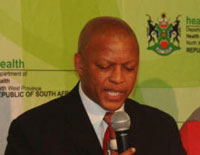Ambulances just for pregnant women

"In our province we have established that there are women who have been giving birth outside health facilities or in transit to the health facility," said Tebogo Lekgethwane, spokesperson for the North West Health Department.
"This has had negative impact on maternal and infant mortality because by giving birth outside a health facility without nurses in attendance, a pregnant mother and the infant are exposed to risks and complications which would have been immediately attended to if they were in a facility."
During a speech in Mmabatho on 22 May, where he explained the breakdown of the department's R7.6-billion (US$760 000) budget, North West Health MEC Dr Magome Masike explained that the provincial department established maternity waiting homes and bought obstetric ambulances for the exclusive transport needs of pregnant women.
He mentioned that 13 maternity waiting homes were established and that 10 were functional across the four municipal districts in the province. Seven were located in the Dr Ruth Segomotsi Mompati district munipality - a "largely rural" area - three in Bojanala, two in Ngaka Modiri Molema and one in Dr Kenneth Kaunda.
The department also aimed to increase the number of waiting homes in 2013 and 2014. "We are on course to saving mothers and babies at birth," said Masike. "Maternal mortality rate in South Africa has declined from 176 per 100 000 live births from 2008 to 2010, to 153.2 per 100 000 live births in 2011." In the North West, he added, the corresponding figure was 145.6 per 100 000, down from 229.5.
He explained that in the 2008 - 2010 reporting period, the North West, Free State and Northern Cape were the worst three performing provinces in terms of maternal mortality. Now the North West is one of country's top three performing provinces, according to a report released in 2011 by the National Committee for the Confidential Enquiries into Maternal Deaths.
Masike also noted that three more milk banks had been established at the Job Shimankane Tabane, Joe Morolong and Mafikeng provincial hospitals, in addition to the one at Potchefstroom hospital.
"Maternity waiting homes will allow women to be nearer to health facilities in the last two weeks towards delivery due date," Lekgethwane explained. "Obstetric ambulances will immediately be accessible to pregnant mothers at the time of emergency and this will improve the response time because they will only respond to maternity cases."
The special obstetric ambulances differ from other ambulances, Lekgethwane said, in that they will be converted to meet the specific demands of a pregnant mother - so they will carry equipment needed in case a mother gives birth in transit. The team will include a midwife to ensure the safe delivery of the child, should this happen in transit or at home.
Tackling maternal mortality
According to a report released in 2011 by Human Rights Watch, titled Stop Making Excuses: Accountability for Maternal Health Care in South Africa, the UN estimated that 4 500 women die each year in South Africa because of preventable and treatable pregnancy and childbirth-related causes.
This report was based on field research between August 2010 and April 2011 with maternity patients, families, community caregivers, health and human rights experts, health workers, government officials, and representatives of donor and international agencies.
However a 2012 report, issued in 2012 by the Committee on Morbidity and Mortality in Children under Five Years, indicates that the national infant mortality rate has dropped from 47.4 per 1 000 live births in 2007, to 38.1 per 1 000.
The statistic for the North West showed a clear improvement, from 77.6 per 1 000 live births to 48.4 per 1 000, while the under-five mortality rate decreased from 62.1 per 1 000 in 2007 to 50.7 per 1 000.
According to the North West's MEC for finance, Paul Sebegoe, the provincial economy is driven mainly by the mining, agriculture and tourism sectors, and is expected to grow by around 2% on average in 2013.
"We cannot afford to deny the masses of our people their right to dignity and decent life, and infrastructure development remains key towards unlocking development opportunities for the people of this province," he said. "If we do not succeed we would have failed all of us."
The North West provincial population contributed 7.2% to the total population in 1996; 6.7% in 2001 and 6.3% in 2007.The recently published census data by Statistics South Africa indicated that the province has a population of 3.5-million, resulting in a slight increase in national population share to 6.8% in 2011.
This is attributed to various factors such as migration, increased birth rate and increased life expectancy.
Source: MediaClubSouthAfrica.com
MediaClubSouthAfrica.com is hosted by the International Marketing Council of South Africa (IMC), the custodian of Brand South Africa. The site is a free service for all media professionals - journalists, editors, writers, designers, picture editors and more - as well as for non-profit organisations and private individuals. Its specific focus is on South Africa and Africa.
Go to: http://www.mediaclubsouthafrica.com/













